Analyzing the Changing Power Dynamics in Digital Media
VerifiedAdded on 2023/01/23
|11
|2990
|73
Essay
AI Summary
This essay analyzes the evolving dynamics of digital media and its impact on power relationships within the context of media and communication. It investigates how digital platforms have reshaped information consumption, challenged traditional power structures, and influenced societal interactions. The paper examines the shift from traditional media to digital platforms, the changing roles of different groups (men vs. women, developed vs. developing nations), and the influence of globalization and technology. The essay discusses the application of the “magic bullet” model to understand how messages are received and the impact of digital media on women's empowerment and political discourse. It explores the changes in advertising, entertainment, and journalism, as well as the role of social media and artificial intelligence in shaping power dynamics. The analysis highlights the importance of understanding these changes in the context of globalization and the democratization of information and content creation, providing a comprehensive overview of the evolving media landscape.
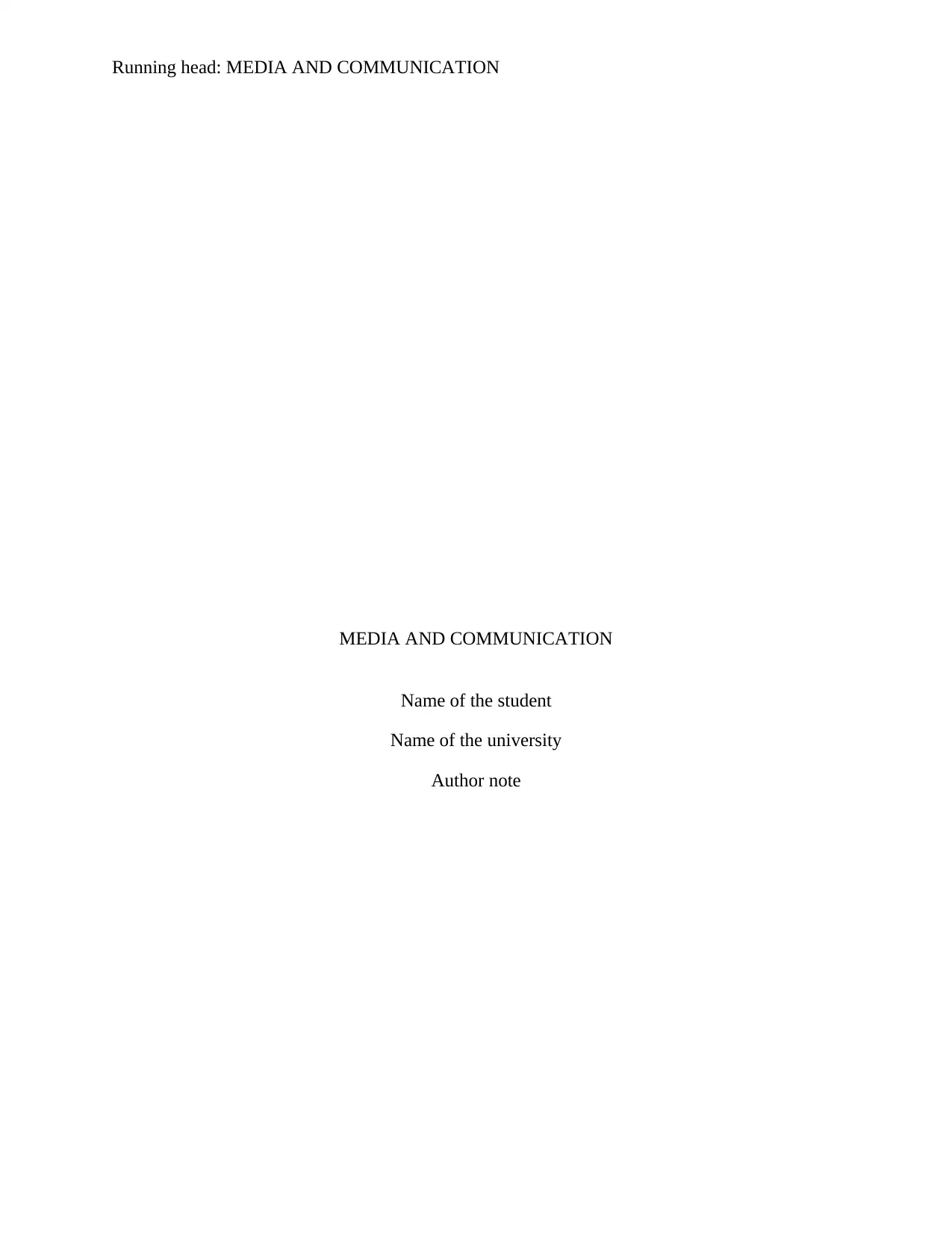
Running head: MEDIA AND COMMUNICATION
MEDIA AND COMMUNICATION
Name of the student
Name of the university
Author note
MEDIA AND COMMUNICATION
Name of the student
Name of the university
Author note
Paraphrase This Document
Need a fresh take? Get an instant paraphrase of this document with our AI Paraphraser

1MEDIA AND COMMUNICATION
Introduction
The aim of the paper is to analyze the issue of the changing dynamics of digital media in
altering the power relationship within the context of media and communication. This paper will
be investigating the subject of the changing dynamics of the digital media and the nature of their
change which has led to the process of change in the earlier relationship between different
communities of people. Power relation is the wider term with sophisticated understanding since
it is divided into the number of groups of identities. This relationship can be understood by the
classification of men v women, black and white, homosexuals and heterosexual, middle-class v
the upper class and many other kinds, what is crucial to note here is that power relationships
exist in society in different form and spaces. There are number of parameters for the change and
reformation in this power relation and media is one of the most prominent ones. Media and
communication, especially with the advent of digital media, have made an impact on the way
power relation is perceived in society.
Discussion
The digital media has largely shaped the way information has been consumed by people,
and it has been observed that digital media is considered to be more than the toll of information
now (Bimber, 2017). This is used as one of the avenues of sharing opinion and views of people
all around the globe; this brings the fragmented aspects of global knowledge sharing into one
platform. The platform of media and communication has undergone significant change in the last
few years with the advent of electronic media. From the age of simple newspaper to the age of
everything being impacted the new media is the unique aspects of this 21st-century media and
Introduction
The aim of the paper is to analyze the issue of the changing dynamics of digital media in
altering the power relationship within the context of media and communication. This paper will
be investigating the subject of the changing dynamics of the digital media and the nature of their
change which has led to the process of change in the earlier relationship between different
communities of people. Power relation is the wider term with sophisticated understanding since
it is divided into the number of groups of identities. This relationship can be understood by the
classification of men v women, black and white, homosexuals and heterosexual, middle-class v
the upper class and many other kinds, what is crucial to note here is that power relationships
exist in society in different form and spaces. There are number of parameters for the change and
reformation in this power relation and media is one of the most prominent ones. Media and
communication, especially with the advent of digital media, have made an impact on the way
power relation is perceived in society.
Discussion
The digital media has largely shaped the way information has been consumed by people,
and it has been observed that digital media is considered to be more than the toll of information
now (Bimber, 2017). This is used as one of the avenues of sharing opinion and views of people
all around the globe; this brings the fragmented aspects of global knowledge sharing into one
platform. The platform of media and communication has undergone significant change in the last
few years with the advent of electronic media. From the age of simple newspaper to the age of
everything being impacted the new media is the unique aspects of this 21st-century media and

2MEDIA AND COMMUNICATION
communication (Bjola et al., 2015). The nature of media and communication has brought a
profound transformation in the way people communicated through the media. This new age of
communication has been changing the way information is shared across the globe. This
information revolution with the process of economic liberalization has led to the operation of
new ownership of the global media by some of the large companies (Boulianne, 2018). One of
the most significant changes that the field of media and communication has been witnessing is
the change in the structural changes. However it is not to deny the fact that the changing
dynamics of the new media is also reaping benefit for the developing nations, with the advent of
democracy and government deregulation, technology has penetrated the rural areas of the
developing countries (Bimber, 2017). This paper will be evaluating the changing nature of power
relation between groups by understanding the ways in which message is received through the
application of the “magic bullet” model.
Some of the changes that have occurred due to the advent of the digital media are the
change in power relations of men and women. One of the first changes that have happened is that
digital media platform have been used by women to a greater extent (Turkle , 2016). This is
significant to note that this new media has provided a new platform with the people especially
the women to build community relations. Women of diverse background and different fields
have gained access to the world of knowledge and facilitated the process of change. The roles of
leadership, men, have dominated the platform for long (Bjola et al., 2015). However, with the
advent of digital media, it has been observed that women have been equally sharing and
amplifying their ideas. Women especially form different communities. This will be looking into
the issue of why how and what of the changes in the power relation of the digital media (Turkle ,
communication (Bjola et al., 2015). The nature of media and communication has brought a
profound transformation in the way people communicated through the media. This new age of
communication has been changing the way information is shared across the globe. This
information revolution with the process of economic liberalization has led to the operation of
new ownership of the global media by some of the large companies (Boulianne, 2018). One of
the most significant changes that the field of media and communication has been witnessing is
the change in the structural changes. However it is not to deny the fact that the changing
dynamics of the new media is also reaping benefit for the developing nations, with the advent of
democracy and government deregulation, technology has penetrated the rural areas of the
developing countries (Bimber, 2017). This paper will be evaluating the changing nature of power
relation between groups by understanding the ways in which message is received through the
application of the “magic bullet” model.
Some of the changes that have occurred due to the advent of the digital media are the
change in power relations of men and women. One of the first changes that have happened is that
digital media platform have been used by women to a greater extent (Turkle , 2016). This is
significant to note that this new media has provided a new platform with the people especially
the women to build community relations. Women of diverse background and different fields
have gained access to the world of knowledge and facilitated the process of change. The roles of
leadership, men, have dominated the platform for long (Bjola et al., 2015). However, with the
advent of digital media, it has been observed that women have been equally sharing and
amplifying their ideas. Women especially form different communities. This will be looking into
the issue of why how and what of the changes in the power relation of the digital media (Turkle ,
⊘ This is a preview!⊘
Do you want full access?
Subscribe today to unlock all pages.

Trusted by 1+ million students worldwide
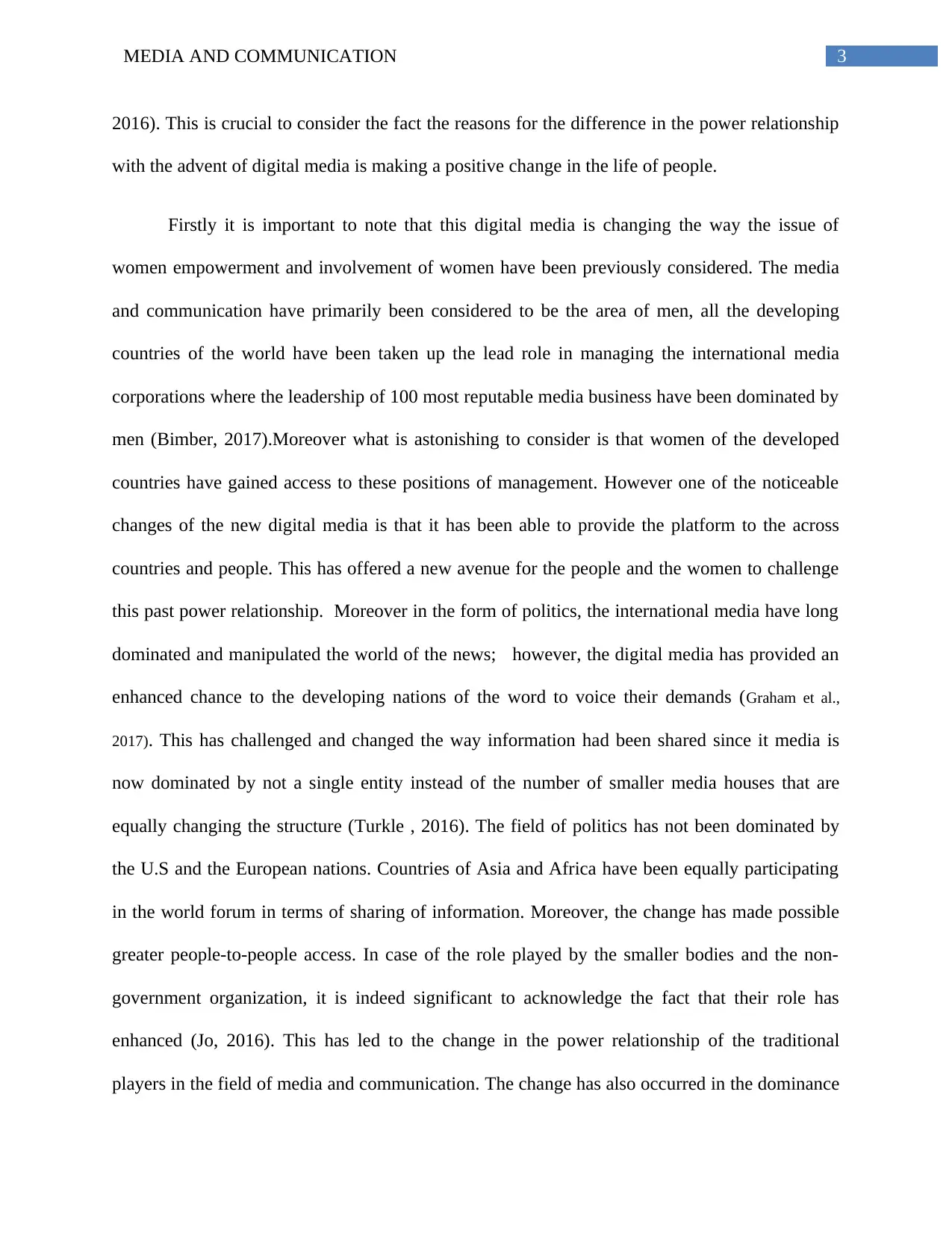
3MEDIA AND COMMUNICATION
2016). This is crucial to consider the fact the reasons for the difference in the power relationship
with the advent of digital media is making a positive change in the life of people.
Firstly it is important to note that this digital media is changing the way the issue of
women empowerment and involvement of women have been previously considered. The media
and communication have primarily been considered to be the area of men, all the developing
countries of the world have been taken up the lead role in managing the international media
corporations where the leadership of 100 most reputable media business have been dominated by
men (Bimber, 2017).Moreover what is astonishing to consider is that women of the developed
countries have gained access to these positions of management. However one of the noticeable
changes of the new digital media is that it has been able to provide the platform to the across
countries and people. This has offered a new avenue for the people and the women to challenge
this past power relationship. Moreover in the form of politics, the international media have long
dominated and manipulated the world of the news; however, the digital media has provided an
enhanced chance to the developing nations of the word to voice their demands (Graham et al.,
2017). This has challenged and changed the way information had been shared since it media is
now dominated by not a single entity instead of the number of smaller media houses that are
equally changing the structure (Turkle , 2016). The field of politics has not been dominated by
the U.S and the European nations. Countries of Asia and Africa have been equally participating
in the world forum in terms of sharing of information. Moreover, the change has made possible
greater people-to-people access. In case of the role played by the smaller bodies and the non-
government organization, it is indeed significant to acknowledge the fact that their role has
enhanced (Jo, 2016). This has led to the change in the power relationship of the traditional
players in the field of media and communication. The change has also occurred in the dominance
2016). This is crucial to consider the fact the reasons for the difference in the power relationship
with the advent of digital media is making a positive change in the life of people.
Firstly it is important to note that this digital media is changing the way the issue of
women empowerment and involvement of women have been previously considered. The media
and communication have primarily been considered to be the area of men, all the developing
countries of the world have been taken up the lead role in managing the international media
corporations where the leadership of 100 most reputable media business have been dominated by
men (Bimber, 2017).Moreover what is astonishing to consider is that women of the developed
countries have gained access to these positions of management. However one of the noticeable
changes of the new digital media is that it has been able to provide the platform to the across
countries and people. This has offered a new avenue for the people and the women to challenge
this past power relationship. Moreover in the form of politics, the international media have long
dominated and manipulated the world of the news; however, the digital media has provided an
enhanced chance to the developing nations of the word to voice their demands (Graham et al.,
2017). This has challenged and changed the way information had been shared since it media is
now dominated by not a single entity instead of the number of smaller media houses that are
equally changing the structure (Turkle , 2016). The field of politics has not been dominated by
the U.S and the European nations. Countries of Asia and Africa have been equally participating
in the world forum in terms of sharing of information. Moreover, the change has made possible
greater people-to-people access. In case of the role played by the smaller bodies and the non-
government organization, it is indeed significant to acknowledge the fact that their role has
enhanced (Jo, 2016). This has led to the change in the power relationship of the traditional
players in the field of media and communication. The change has also occurred in the dominance
Paraphrase This Document
Need a fresh take? Get an instant paraphrase of this document with our AI Paraphraser
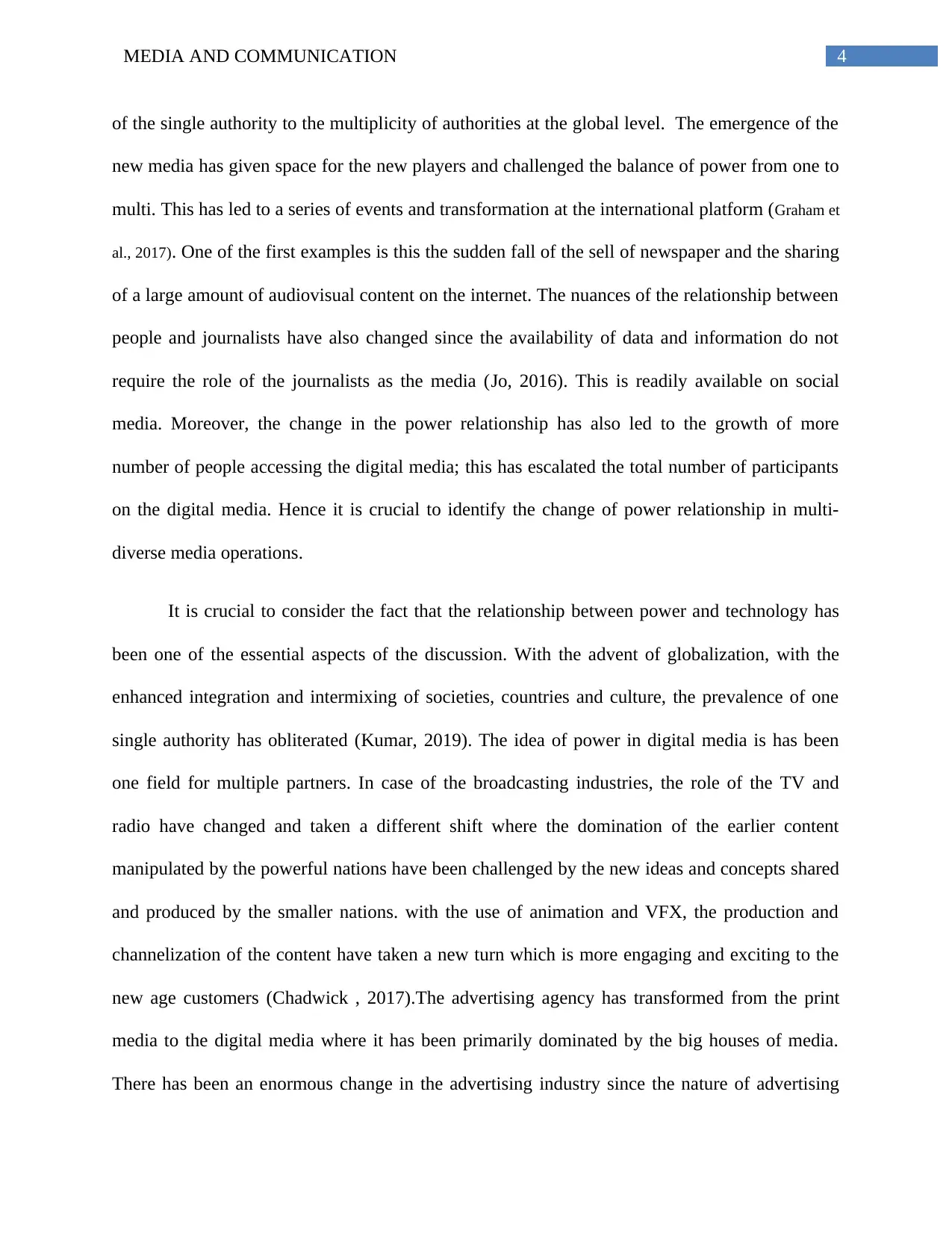
4MEDIA AND COMMUNICATION
of the single authority to the multiplicity of authorities at the global level. The emergence of the
new media has given space for the new players and challenged the balance of power from one to
multi. This has led to a series of events and transformation at the international platform (Graham et
al., 2017). One of the first examples is this the sudden fall of the sell of newspaper and the sharing
of a large amount of audiovisual content on the internet. The nuances of the relationship between
people and journalists have also changed since the availability of data and information do not
require the role of the journalists as the media (Jo, 2016). This is readily available on social
media. Moreover, the change in the power relationship has also led to the growth of more
number of people accessing the digital media; this has escalated the total number of participants
on the digital media. Hence it is crucial to identify the change of power relationship in multi-
diverse media operations.
It is crucial to consider the fact that the relationship between power and technology has
been one of the essential aspects of the discussion. With the advent of globalization, with the
enhanced integration and intermixing of societies, countries and culture, the prevalence of one
single authority has obliterated (Kumar, 2019). The idea of power in digital media is has been
one field for multiple partners. In case of the broadcasting industries, the role of the TV and
radio have changed and taken a different shift where the domination of the earlier content
manipulated by the powerful nations have been challenged by the new ideas and concepts shared
and produced by the smaller nations. with the use of animation and VFX, the production and
channelization of the content have taken a new turn which is more engaging and exciting to the
new age customers (Chadwick , 2017).The advertising agency has transformed from the print
media to the digital media where it has been primarily dominated by the big houses of media.
There has been an enormous change in the advertising industry since the nature of advertising
of the single authority to the multiplicity of authorities at the global level. The emergence of the
new media has given space for the new players and challenged the balance of power from one to
multi. This has led to a series of events and transformation at the international platform (Graham et
al., 2017). One of the first examples is this the sudden fall of the sell of newspaper and the sharing
of a large amount of audiovisual content on the internet. The nuances of the relationship between
people and journalists have also changed since the availability of data and information do not
require the role of the journalists as the media (Jo, 2016). This is readily available on social
media. Moreover, the change in the power relationship has also led to the growth of more
number of people accessing the digital media; this has escalated the total number of participants
on the digital media. Hence it is crucial to identify the change of power relationship in multi-
diverse media operations.
It is crucial to consider the fact that the relationship between power and technology has
been one of the essential aspects of the discussion. With the advent of globalization, with the
enhanced integration and intermixing of societies, countries and culture, the prevalence of one
single authority has obliterated (Kumar, 2019). The idea of power in digital media is has been
one field for multiple partners. In case of the broadcasting industries, the role of the TV and
radio have changed and taken a different shift where the domination of the earlier content
manipulated by the powerful nations have been challenged by the new ideas and concepts shared
and produced by the smaller nations. with the use of animation and VFX, the production and
channelization of the content have taken a new turn which is more engaging and exciting to the
new age customers (Chadwick , 2017).The advertising agency has transformed from the print
media to the digital media where it has been primarily dominated by the big houses of media.
There has been an enormous change in the advertising industry since the nature of advertising
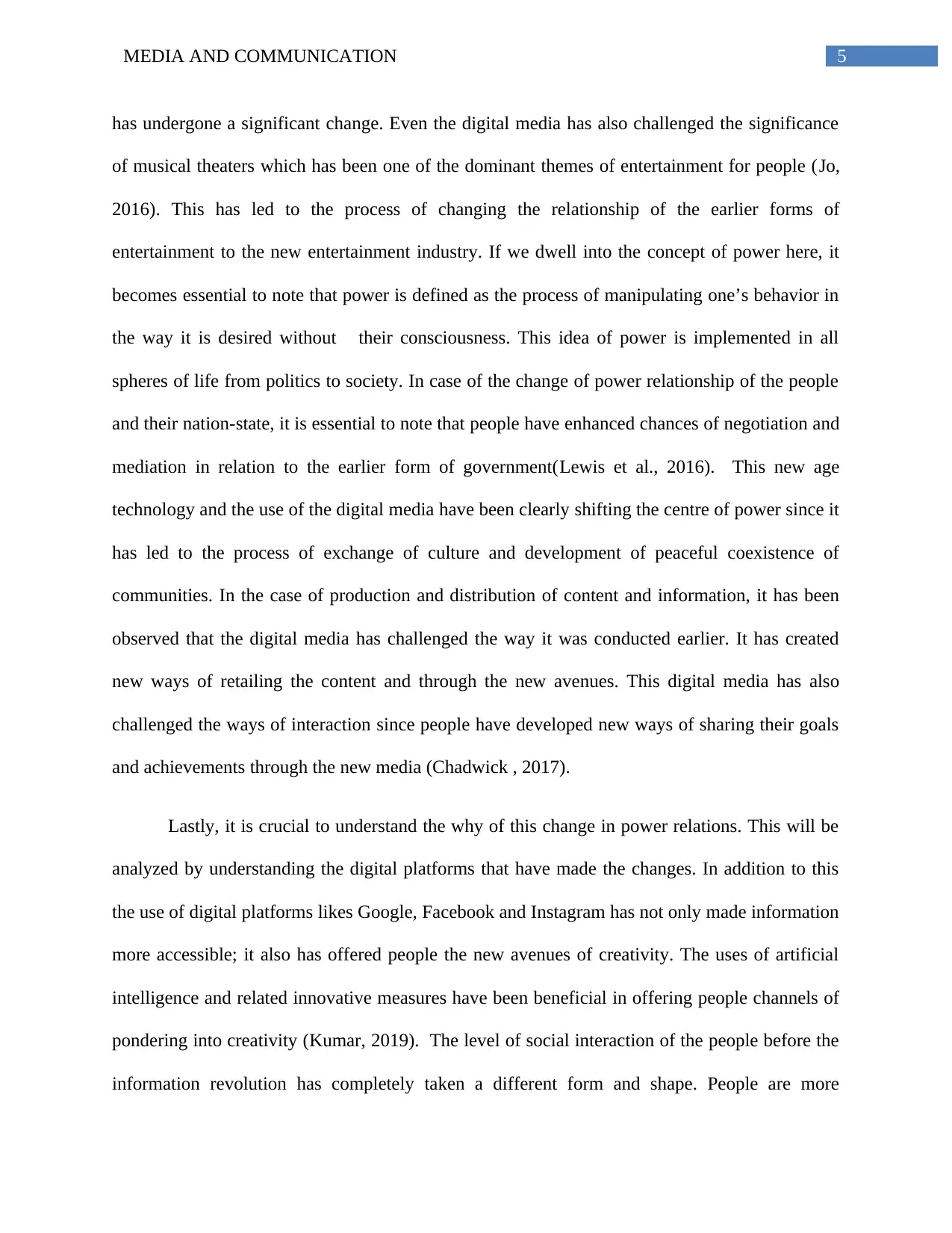
5MEDIA AND COMMUNICATION
has undergone a significant change. Even the digital media has also challenged the significance
of musical theaters which has been one of the dominant themes of entertainment for people (Jo,
2016). This has led to the process of changing the relationship of the earlier forms of
entertainment to the new entertainment industry. If we dwell into the concept of power here, it
becomes essential to note that power is defined as the process of manipulating one’s behavior in
the way it is desired without their consciousness. This idea of power is implemented in all
spheres of life from politics to society. In case of the change of power relationship of the people
and their nation-state, it is essential to note that people have enhanced chances of negotiation and
mediation in relation to the earlier form of government(Lewis et al., 2016). This new age
technology and the use of the digital media have been clearly shifting the centre of power since it
has led to the process of exchange of culture and development of peaceful coexistence of
communities. In the case of production and distribution of content and information, it has been
observed that the digital media has challenged the way it was conducted earlier. It has created
new ways of retailing the content and through the new avenues. This digital media has also
challenged the ways of interaction since people have developed new ways of sharing their goals
and achievements through the new media (Chadwick , 2017).
Lastly, it is crucial to understand the why of this change in power relations. This will be
analyzed by understanding the digital platforms that have made the changes. In addition to this
the use of digital platforms likes Google, Facebook and Instagram has not only made information
more accessible; it also has offered people the new avenues of creativity. The uses of artificial
intelligence and related innovative measures have been beneficial in offering people channels of
pondering into creativity (Kumar, 2019). The level of social interaction of the people before the
information revolution has completely taken a different form and shape. People are more
has undergone a significant change. Even the digital media has also challenged the significance
of musical theaters which has been one of the dominant themes of entertainment for people (Jo,
2016). This has led to the process of changing the relationship of the earlier forms of
entertainment to the new entertainment industry. If we dwell into the concept of power here, it
becomes essential to note that power is defined as the process of manipulating one’s behavior in
the way it is desired without their consciousness. This idea of power is implemented in all
spheres of life from politics to society. In case of the change of power relationship of the people
and their nation-state, it is essential to note that people have enhanced chances of negotiation and
mediation in relation to the earlier form of government(Lewis et al., 2016). This new age
technology and the use of the digital media have been clearly shifting the centre of power since it
has led to the process of exchange of culture and development of peaceful coexistence of
communities. In the case of production and distribution of content and information, it has been
observed that the digital media has challenged the way it was conducted earlier. It has created
new ways of retailing the content and through the new avenues. This digital media has also
challenged the ways of interaction since people have developed new ways of sharing their goals
and achievements through the new media (Chadwick , 2017).
Lastly, it is crucial to understand the why of this change in power relations. This will be
analyzed by understanding the digital platforms that have made the changes. In addition to this
the use of digital platforms likes Google, Facebook and Instagram has not only made information
more accessible; it also has offered people the new avenues of creativity. The uses of artificial
intelligence and related innovative measures have been beneficial in offering people channels of
pondering into creativity (Kumar, 2019). The level of social interaction of the people before the
information revolution has completely taken a different form and shape. People are more
⊘ This is a preview!⊘
Do you want full access?
Subscribe today to unlock all pages.

Trusted by 1+ million students worldwide
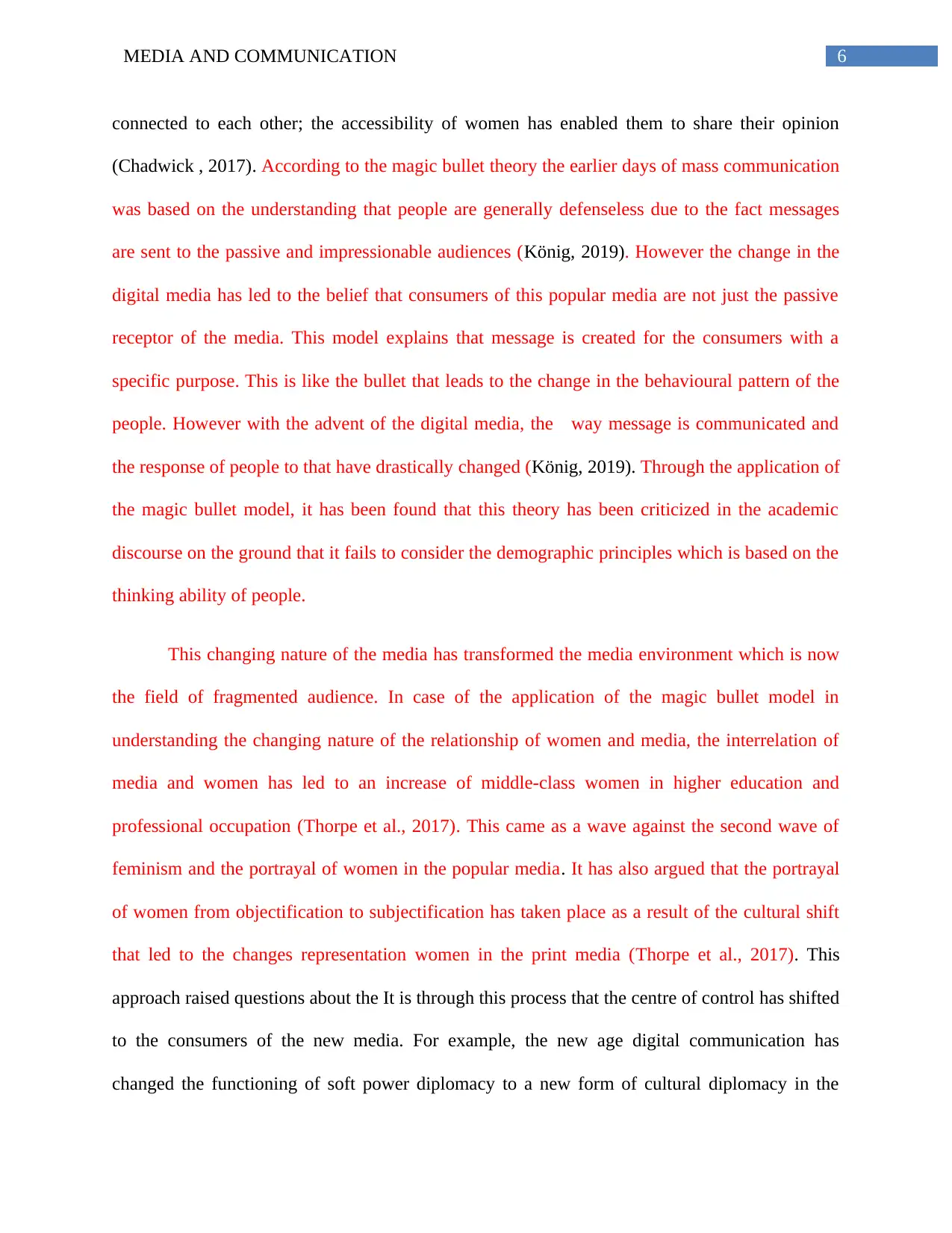
6MEDIA AND COMMUNICATION
connected to each other; the accessibility of women has enabled them to share their opinion
(Chadwick , 2017). According to the magic bullet theory the earlier days of mass communication
was based on the understanding that people are generally defenseless due to the fact messages
are sent to the passive and impressionable audiences (König, 2019). However the change in the
digital media has led to the belief that consumers of this popular media are not just the passive
receptor of the media. This model explains that message is created for the consumers with a
specific purpose. This is like the bullet that leads to the change in the behavioural pattern of the
people. However with the advent of the digital media, the way message is communicated and
the response of people to that have drastically changed (König, 2019). Through the application of
the magic bullet model, it has been found that this theory has been criticized in the academic
discourse on the ground that it fails to consider the demographic principles which is based on the
thinking ability of people.
This changing nature of the media has transformed the media environment which is now
the field of fragmented audience. In case of the application of the magic bullet model in
understanding the changing nature of the relationship of women and media, the interrelation of
media and women has led to an increase of middle-class women in higher education and
professional occupation (Thorpe et al., 2017). This came as a wave against the second wave of
feminism and the portrayal of women in the popular media. It has also argued that the portrayal
of women from objectification to subjectification has taken place as a result of the cultural shift
that led to the changes representation women in the print media (Thorpe et al., 2017). This
approach raised questions about the It is through this process that the centre of control has shifted
to the consumers of the new media. For example, the new age digital communication has
changed the functioning of soft power diplomacy to a new form of cultural diplomacy in the
connected to each other; the accessibility of women has enabled them to share their opinion
(Chadwick , 2017). According to the magic bullet theory the earlier days of mass communication
was based on the understanding that people are generally defenseless due to the fact messages
are sent to the passive and impressionable audiences (König, 2019). However the change in the
digital media has led to the belief that consumers of this popular media are not just the passive
receptor of the media. This model explains that message is created for the consumers with a
specific purpose. This is like the bullet that leads to the change in the behavioural pattern of the
people. However with the advent of the digital media, the way message is communicated and
the response of people to that have drastically changed (König, 2019). Through the application of
the magic bullet model, it has been found that this theory has been criticized in the academic
discourse on the ground that it fails to consider the demographic principles which is based on the
thinking ability of people.
This changing nature of the media has transformed the media environment which is now
the field of fragmented audience. In case of the application of the magic bullet model in
understanding the changing nature of the relationship of women and media, the interrelation of
media and women has led to an increase of middle-class women in higher education and
professional occupation (Thorpe et al., 2017). This came as a wave against the second wave of
feminism and the portrayal of women in the popular media. It has also argued that the portrayal
of women from objectification to subjectification has taken place as a result of the cultural shift
that led to the changes representation women in the print media (Thorpe et al., 2017). This
approach raised questions about the It is through this process that the centre of control has shifted
to the consumers of the new media. For example, the new age digital communication has
changed the functioning of soft power diplomacy to a new form of cultural diplomacy in the
Paraphrase This Document
Need a fresh take? Get an instant paraphrase of this document with our AI Paraphraser
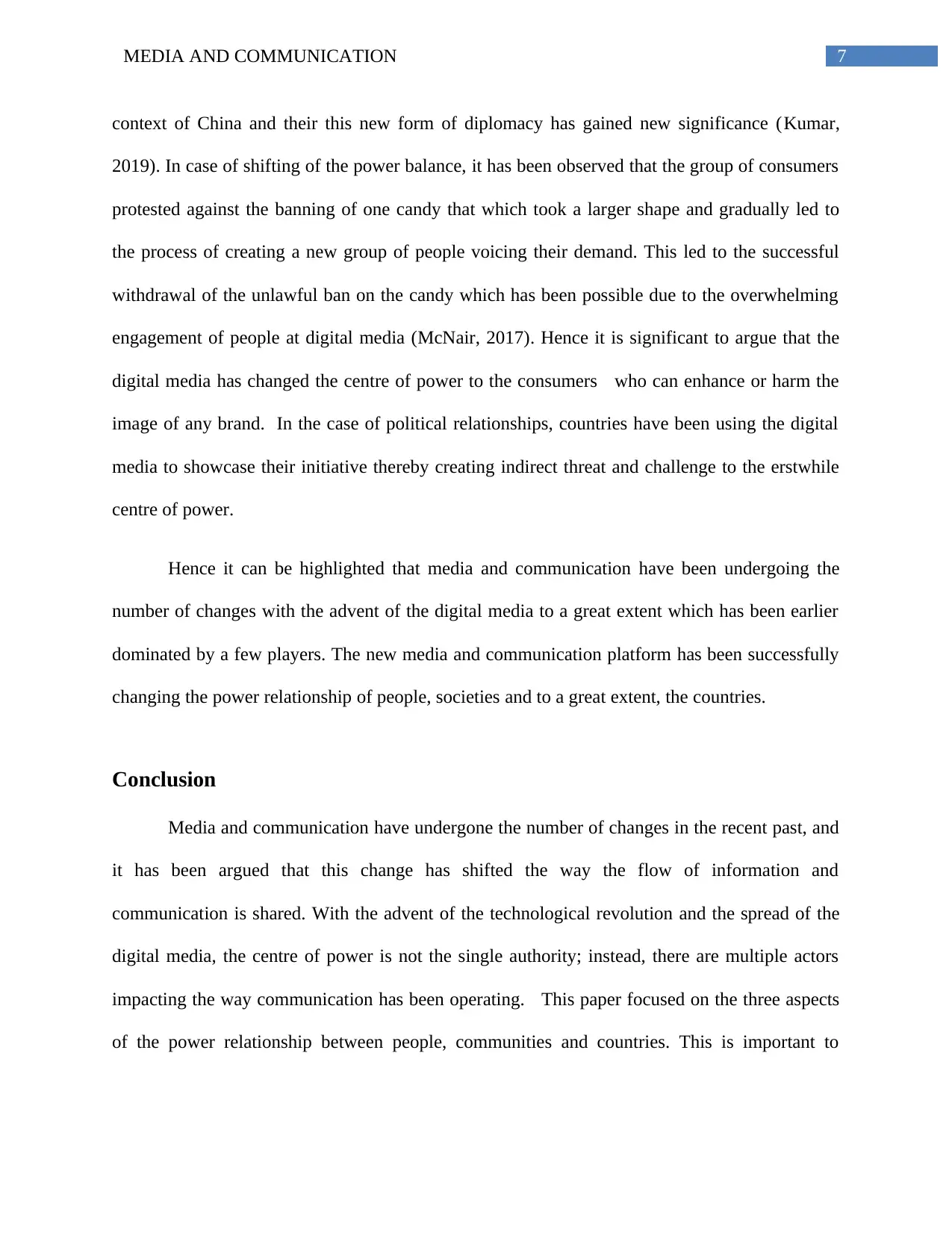
7MEDIA AND COMMUNICATION
context of China and their this new form of diplomacy has gained new significance (Kumar,
2019). In case of shifting of the power balance, it has been observed that the group of consumers
protested against the banning of one candy that which took a larger shape and gradually led to
the process of creating a new group of people voicing their demand. This led to the successful
withdrawal of the unlawful ban on the candy which has been possible due to the overwhelming
engagement of people at digital media (McNair, 2017). Hence it is significant to argue that the
digital media has changed the centre of power to the consumers who can enhance or harm the
image of any brand. In the case of political relationships, countries have been using the digital
media to showcase their initiative thereby creating indirect threat and challenge to the erstwhile
centre of power.
Hence it can be highlighted that media and communication have been undergoing the
number of changes with the advent of the digital media to a great extent which has been earlier
dominated by a few players. The new media and communication platform has been successfully
changing the power relationship of people, societies and to a great extent, the countries.
Conclusion
Media and communication have undergone the number of changes in the recent past, and
it has been argued that this change has shifted the way the flow of information and
communication is shared. With the advent of the technological revolution and the spread of the
digital media, the centre of power is not the single authority; instead, there are multiple actors
impacting the way communication has been operating. This paper focused on the three aspects
of the power relationship between people, communities and countries. This is important to
context of China and their this new form of diplomacy has gained new significance (Kumar,
2019). In case of shifting of the power balance, it has been observed that the group of consumers
protested against the banning of one candy that which took a larger shape and gradually led to
the process of creating a new group of people voicing their demand. This led to the successful
withdrawal of the unlawful ban on the candy which has been possible due to the overwhelming
engagement of people at digital media (McNair, 2017). Hence it is significant to argue that the
digital media has changed the centre of power to the consumers who can enhance or harm the
image of any brand. In the case of political relationships, countries have been using the digital
media to showcase their initiative thereby creating indirect threat and challenge to the erstwhile
centre of power.
Hence it can be highlighted that media and communication have been undergoing the
number of changes with the advent of the digital media to a great extent which has been earlier
dominated by a few players. The new media and communication platform has been successfully
changing the power relationship of people, societies and to a great extent, the countries.
Conclusion
Media and communication have undergone the number of changes in the recent past, and
it has been argued that this change has shifted the way the flow of information and
communication is shared. With the advent of the technological revolution and the spread of the
digital media, the centre of power is not the single authority; instead, there are multiple actors
impacting the way communication has been operating. This paper focused on the three aspects
of the power relationship between people, communities and countries. This is important to
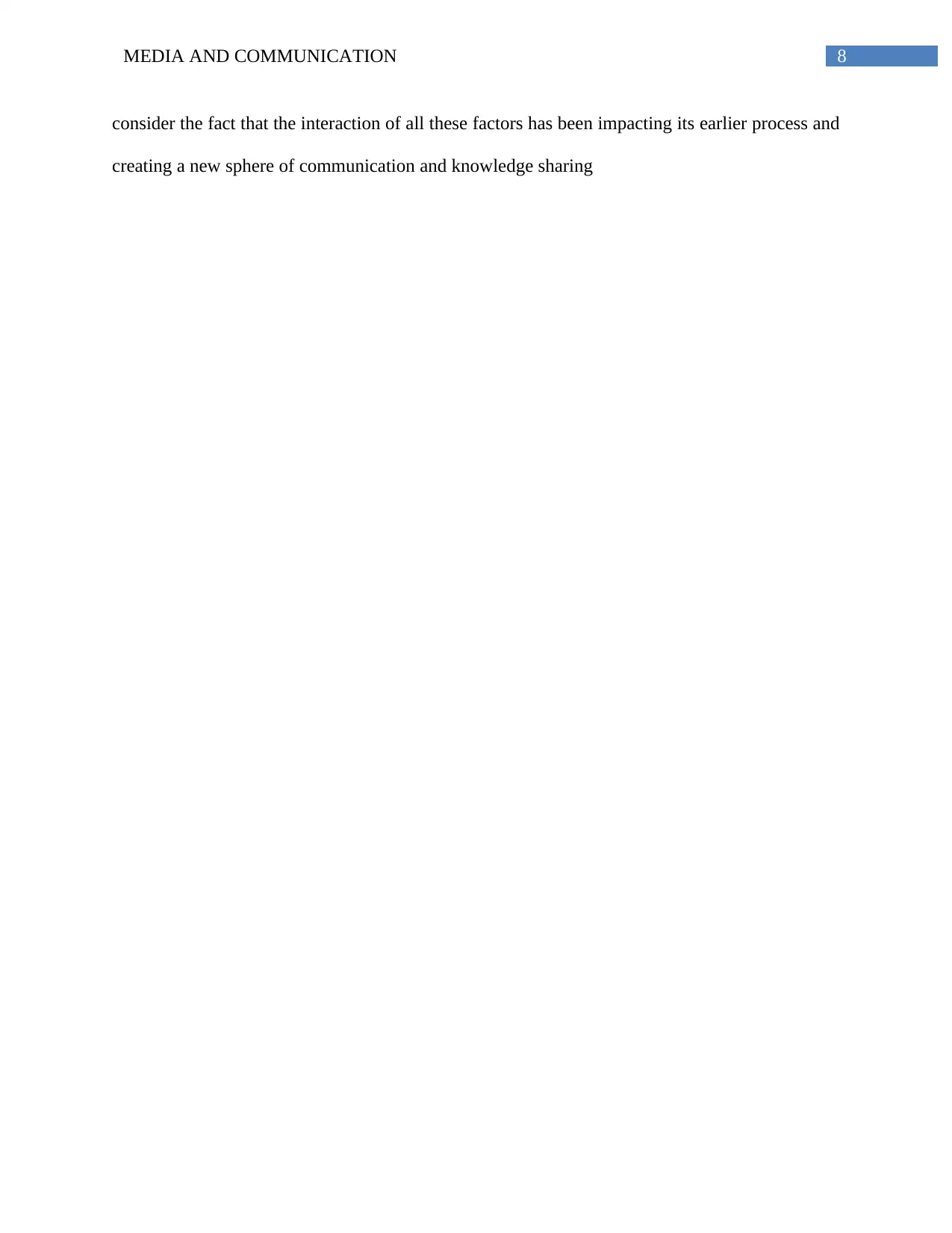
8MEDIA AND COMMUNICATION
consider the fact that the interaction of all these factors has been impacting its earlier process and
creating a new sphere of communication and knowledge sharing
consider the fact that the interaction of all these factors has been impacting its earlier process and
creating a new sphere of communication and knowledge sharing
⊘ This is a preview!⊘
Do you want full access?
Subscribe today to unlock all pages.

Trusted by 1+ million students worldwide

9MEDIA AND COMMUNICATION
References
Bimber, B. (2017). Three prompts for collective action in the context of digital media. Political
Communication, 34(1), 6-20.
Bjola, C., & Holmes, M. (2015). Digital Diplomacy: Theory and practice. Routledge.
Boulianne, S. (2018). Twenty years of digital media effects on civic and political
participation. Communication research, 0093650218808186.
Chadwick, A. (2017). The hybrid media system: Politics and power. Oxford University Press.
Graham, T., & Broersma, M. (2015). Tipping the balance of power: Social media and the transformation of political
journalism. The Routledge companion to social media and politics (pp. 111-125). Routledge.
Jo, S. (2016). 13 The interplay in the Digital Media Environment. The Moral Compass of Public
Relations, 185.
Kumar, V. R. (2019). Transformation of Communication: Rise of Internet Society. International
Journal of Current Humanities and Social Science Researches (IJCHSSR), 3(1), 16-19.
Lewis, S. C., Holton, A. E., & Coddington, M. (2016). From participation to reciprocity in the
journalist-audience relationship. Rethinking Journalism Again: Societal role and public
relevance in a digital age, 161-174.
Turkle, S. (2016). Reclaiming conversation: The power of talk in a digital age. Penguin.
McNair, B. (2017). An introduction to political communication. Routledge.
References
Bimber, B. (2017). Three prompts for collective action in the context of digital media. Political
Communication, 34(1), 6-20.
Bjola, C., & Holmes, M. (2015). Digital Diplomacy: Theory and practice. Routledge.
Boulianne, S. (2018). Twenty years of digital media effects on civic and political
participation. Communication research, 0093650218808186.
Chadwick, A. (2017). The hybrid media system: Politics and power. Oxford University Press.
Graham, T., & Broersma, M. (2015). Tipping the balance of power: Social media and the transformation of political
journalism. The Routledge companion to social media and politics (pp. 111-125). Routledge.
Jo, S. (2016). 13 The interplay in the Digital Media Environment. The Moral Compass of Public
Relations, 185.
Kumar, V. R. (2019). Transformation of Communication: Rise of Internet Society. International
Journal of Current Humanities and Social Science Researches (IJCHSSR), 3(1), 16-19.
Lewis, S. C., Holton, A. E., & Coddington, M. (2016). From participation to reciprocity in the
journalist-audience relationship. Rethinking Journalism Again: Societal role and public
relevance in a digital age, 161-174.
Turkle, S. (2016). Reclaiming conversation: The power of talk in a digital age. Penguin.
McNair, B. (2017). An introduction to political communication. Routledge.
Paraphrase This Document
Need a fresh take? Get an instant paraphrase of this document with our AI Paraphraser
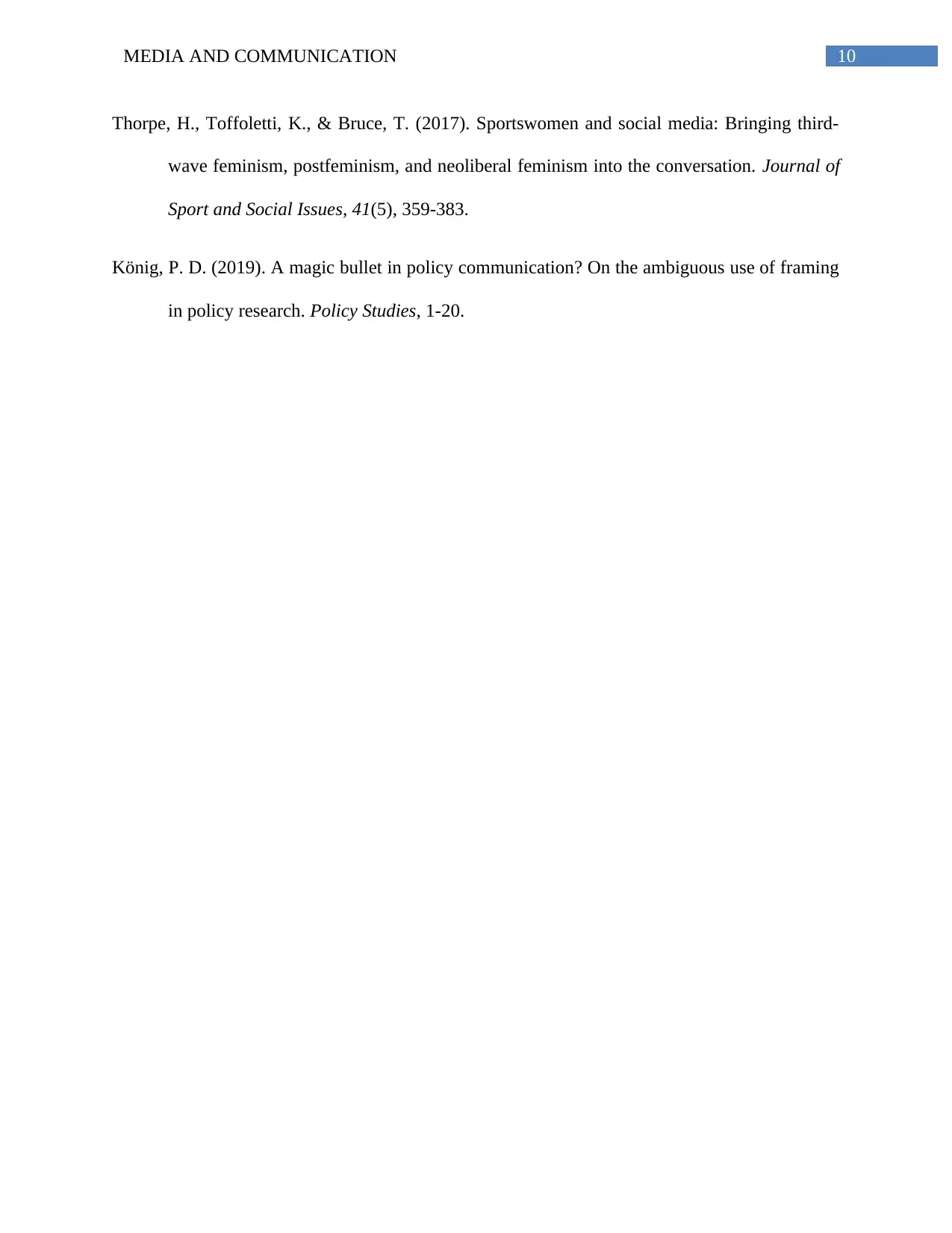
10MEDIA AND COMMUNICATION
Thorpe, H., Toffoletti, K., & Bruce, T. (2017). Sportswomen and social media: Bringing third-
wave feminism, postfeminism, and neoliberal feminism into the conversation. Journal of
Sport and Social Issues, 41(5), 359-383.
König, P. D. (2019). A magic bullet in policy communication? On the ambiguous use of framing
in policy research. Policy Studies, 1-20.
Thorpe, H., Toffoletti, K., & Bruce, T. (2017). Sportswomen and social media: Bringing third-
wave feminism, postfeminism, and neoliberal feminism into the conversation. Journal of
Sport and Social Issues, 41(5), 359-383.
König, P. D. (2019). A magic bullet in policy communication? On the ambiguous use of framing
in policy research. Policy Studies, 1-20.
1 out of 11
Related Documents
Your All-in-One AI-Powered Toolkit for Academic Success.
+13062052269
info@desklib.com
Available 24*7 on WhatsApp / Email
![[object Object]](/_next/static/media/star-bottom.7253800d.svg)
Unlock your academic potential
Copyright © 2020–2025 A2Z Services. All Rights Reserved. Developed and managed by ZUCOL.




